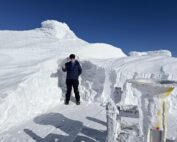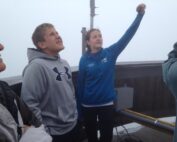A Sequel Worthy of Reading
2011-12-26 18:26:09.000 – Ryan Knapp, Weather Observer/Meteorologist
NULL
Today’s comment is a sequel to a comment I wrote back on June 23rd, 2011, which was a sequel to a comment former observer, Jim Salge wrote back on June 22nd, 2006. So, if Hollywood has taught us anything over the years, it’s that sequels are rarely as good as or better than the originals. But there are a few exceptions; ‘Star Wars: The Empire Strikes Back’, ‘The Godfather 2’, and ‘Terminator 2’ come to mind. But for every one good sequel, there are an endless supply of subpar or awful sequels that probably never should have been made (Home Alone 4 anyone?). So my hope with this comment is to be on the awesome and memorable sequel side of things.
So to catch you up with the past comments, back in June, I wrote about our setting sun during the summer solstice. During the summer, it sets to the northwest and in the winter it sets in the southwest; a difference on the compass of about 66 degrees. That sounds impressive but to the average person, it may be a bit difficult to visualize and since a picture is worth a thousand words, I went about to create such an image. This ended up being easier said than done, taking me five years and six months to accomplish (it will actually be six years this coming Wednesday). So why did it take so long? Our schedules, timing of the solstices/equinox, the weather (fog, haze, clouds, etc), and time itself. But over the span of five years six months, I spent one rainy afternoon looking through thousands of my pictures looking for four images (spring, summer, fall and winter). Then, I spent several hours layering, stitching, cloning, color correcting, aligning and other editing techniques in Photoshop until I finally got the image I was looking for that showed the four (ends up looking like three) setting suns.
At the end of that comment, I mentioned that I wanted to do a similar picture for sunrises. The biggest problem to accomplish this image was my significant lack of sunrise pictures during the winter. My shift runs from 5:30 pm until 5:30 am and in the winter, sunset and sunrise occur outside of this time frame. Getting winter sunsets is easy since I am usually up by the 4 o’clock hours that they occur in. Sunrises, on the other hand, don’t occur until the 7 o’clock hour in winter; a time I rarely want to stay up until to see something I can see during my shift in the summer. So, needless to say, my winter sunrise photos (especially those around the winter solstice) are extremely limited. But I was determined to get this image, so I stayed up until sunrise last shift to get the rising sun on one perfectly clear day.
Again, sorting through thousands of images, I found the four I was looking for but then started to dig around for additional shots to do something even bigger to make this sequel well worth my time and yours. Spending the better part of one of my days off with Photoshop once again, I found myself tweaking, stitching, cloning, rotating, aligning, cropping, and generally editing my various images. What I ended up with was not one additional image but three additional images so that now I have an image that represents the position of the sun for each compass point. So, hopefully this ends up being a sequel worth waiting for and without further ado here are the images:
West – Spring, summer, fall, and winter sunsets (winter far left, spring/fall center, and summer far right)
East – Spring, summer, fall, and winter sunrises (winter far right, spring/fall center, and summer far left)
North – Summer sunrise and sunset (sunrise right and sunset left)
South – Winter sunrise and sunset (sunrise left and sunset right)
Ryan Knapp, Weather Observer/Meteorologist
An Experience Worth 1,000 More
An Experience Worth 1,000 More By Mitchell Tsokatos Me and the summit sign once winter really got going. Taken 11/2/25. Unfortunately, my time on Mount Washington as an intern has come to
Supporter Spotlight: AJ Mastrangelo
Supporter Spotlight: AJ Mastrangelo By Wendy Almeida A young AJ on the summit with Rebecca Scholand. AJ Mastrangelo’s relationship with Mount Washington Observatory began long before his internship—or his current career as
Supporter Spotlight: Angelo Decrisantis
Supporter Spotlight: Angelo Decrisantis By Wendy Almeida For Angelo Decrisantis, Mount Washington has been a lifelong connection. It began in 1965, at age 15, on a family drive to the summit. “My first experience



